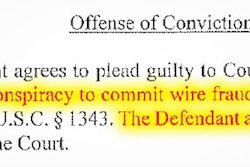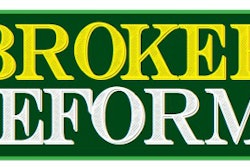Frederic Marcinak and Lesesne Phillips of the transportation-focused Moseley Marcinak Law Group last week spoke to trends they’ve been seeing this year with respect to a scam that many of you will know well. It’s one that, despite federal and state law enforcement’s best efforts, with some success, as we’ve reported, continues and may even be getting more common with such a broad swath of our person-to-person interactions moving to a virtual setting.
It’s identity theft at its root, with thieves getting between legitimate brokers and carriers to steal fuel-advance money and in many cases full load payment that should be going to the carrier. With the increasing prevalence of high spot rates, you might easily see the renewed and growing attraction of this to the crooks.
I wrote about the scheme as part of the “Broker reforms” feature series in March. It starts with thieves, often overseas (allowing them to remain outside the reach of U.S. law enforcement), stealing a legitimate carrier’s ID information, doctoring an insurance certificate so that it appears legit (though with contact information going back directly to the crooks) and convincing a broker to tender them a load. They then take separate stolen broker information and “pose as a broker and double-broker it [often] on that same load board or a different load board,” Phillips said.

They contract with stolen broker information — rate confirmations doctored in ways similar to the insurance certificate they faked to present to the real broker — to basically double-broker it to a motor carrier.
![The real carrier in the hypothetical Marcinak and Phillips presented is on the far right in this diagram, the real broker on the far left. “Moseley thinks it’s dealing with Phillips Trans, but the real person that’s transporting this is Marcinak,” Lesesne Phillips said. (Jackson Logistics is the brokerage the thieves impersonate to double-broker Moseley’s load.) And assuming the real load actually gets delivered, the thieves are successful in taking the full load payment, and Marcinak Trans is left in the lurch, to any broker who might think this is no big deal because load was moved safely, Phillips added this: “The real freight rate that Moseley posted is usually lower than what the ID thief [goes on to post]. They want it to get off the load board really quickly. They usually jack up the rate.” The real carrier is going to want that rate either 1) from you, or 2) your customer.](https://img.overdriveonline.com/files/base/randallreilly/all/image/2020/11/ovd.Transportation-fraud-moseley-marcinak-screenshot-2020-11-11-08-57.png?auto=format%2Ccompress&fit=max&q=70&w=400) The real carrier in the hypothetical Marcinak and Phillips presented is on the far right in this diagram, the real broker on the far left. “Moseley thinks it’s dealing with Phillips Trans, but the real person that’s transporting this is Marcinak,” Lesesne Phillips said. (Jackson Logistics is the brokerage the thieves impersonate to double-broker Moseley’s load.) And assuming the real load actually gets delivered, the thieves are successful in taking the full load payment, and Marcinak Trans is left in the lurch, to any broker who might think this is no big deal because load was moved safely, Phillips added this: “The real freight rate that Moseley posted is usually lower than what the ID thief [goes on to post]. They want it to get off the load board really quickly. They usually jack up the rate.” The real carrier is going to want that rate either 1) from you, or 2) your customer.
The real carrier in the hypothetical Marcinak and Phillips presented is on the far right in this diagram, the real broker on the far left. “Moseley thinks it’s dealing with Phillips Trans, but the real person that’s transporting this is Marcinak,” Lesesne Phillips said. (Jackson Logistics is the brokerage the thieves impersonate to double-broker Moseley’s load.) And assuming the real load actually gets delivered, the thieves are successful in taking the full load payment, and Marcinak Trans is left in the lurch, to any broker who might think this is no big deal because load was moved safely, Phillips added this: “The real freight rate that Moseley posted is usually lower than what the ID thief [goes on to post]. They want it to get off the load board really quickly. They usually jack up the rate.” The real carrier is going to want that rate either 1) from you, or 2) your customer.
What I wanted to emphasize today is twofold:
- Marcinak and Phillips believe this type of scheme is more prevalent this year than it’s been in recent memory. Phillips made note of a conversation with an investigator who “deals with this quite often,” he said. That contact noted frequency has increased four-fold over the course of this year, just as “all internet scams are increasing – because of the nature of this one, it’s a popular one that can pick up steam pretty quickly,” particularly given how high rates in spot negotiations have been going.
- Combating this, particularly for those of you who may utilize an unfamiliar broker often enough, will require both more skepticism and better communication with those parties.
It’s No. 2 that’s most critical. And for brokers working often with first-time carriers, the same ends up being true. Carriers should use the two/three-step independent verification of identifies from third-party sources described by the owner-ops and security specialists I talked to back earlier this year.
For brokers faced with a first-time carrier requesting a fuel advance, think twice about it, and do the same kinds of verification yourself. (Some watchers believe that adopting an industry-standard prohibition on fuel advances for first-time carriers could well stop this scheme altogether.)
Spread awareness amongst your colleagues that this is going on and sucking millions from our transportation system, with carriers arguably bearing the heaviest burden. Make those double- and triple-checks on IDs routine, as frictionless as possible (don’t be quick to take offense when somebody doesn’t immediately believe you are who you say you are – get used to it, as this is the world we live in).
If you do get scammed and find your way back to original party – at least make the effort to work together with everyone involved to root out the bad actors. There are folks in DOT and federal law enforcement who care about this — find reporting avenues to the DOT Office of Inspector General via this link. There you’ll also find avenues to report such incidents to the load boards where these scams begin, too — just as they care about issues of nonpayment from brokers on their platforms, load board vendors are proactive as they can be on rooting out these kinds of bad actors. Make sure to involve them in any instance of this you come across via their platforms.
Other scams involving ID theft
Phillips and Marcinak broke down a few other less-common scenarios that can involve ID theft.
**Cargo thefts of various types.
**Driver ID theft — involving a thief obtaining a driver’s vehicle number and license plate, and the driver’s name, in order to scam a fuel advance out of a fleet dispatcher (it’s happened).
**Fake towing – thieves “call and say they won’t release your truck until payment is received,” Phillips said.
**Freight forwarder scams – the “ID thief poses as a freight forwarder,” then “they withhold the bill of lading to keep the goods from leaving the port of destination. You end up having to pay money in order to get the bill of lading.”
**Customer-related scams — Marcinak was involved in a case of this, he said, where “you actually see fraud from the customer side.” A potential customer comes to you, saying “I want to give you some freight.” This customer fills out any credit applications with “phone numbers and emails on there that they control… For their references, they list emails and phone numbers that go right back to them. From your perspective as a carrier, they’re just hiring you to move freight, but in reality, they have no freight.” Thieves in this scheme go right back out to freight owners and pose as a broker or a carrier. They get a quote from the original carrier, say, for $500, then go to an actual freight owner and say “I’ll move this for $200.” The cargo move, the real freight owner pays the thief $200, who of course never pays the carrier. “Your paperwork for the shipment is going to show the fake customer.” In the LTL context, where Marcinak saw it, the carrier “might get three-four shipments moved before you realize you’re not getting paid.” It happens, though not as frequently as other scenarios.
Catch all seven installments in the Broker Reforms series starting with this one (subsequent stories are linked at the bottom of each post in the run):
Find Marcinak and Philllips’ presentation in full via this link.










